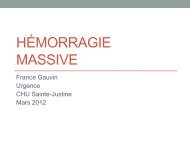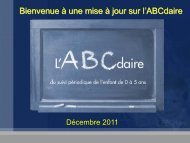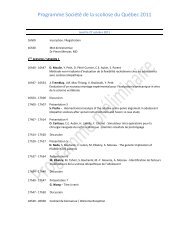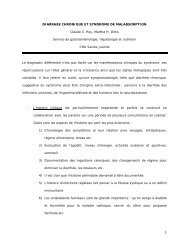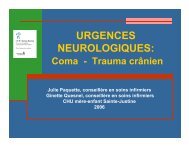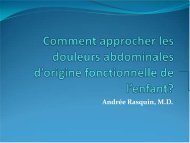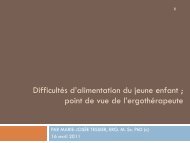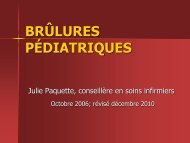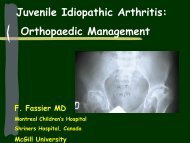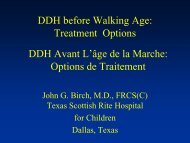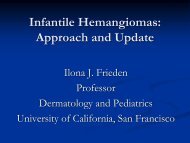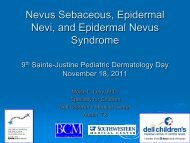Spina Bifida - CHU Sainte-Justine - SAAC
Spina Bifida - CHU Sainte-Justine - SAAC
Spina Bifida - CHU Sainte-Justine - SAAC
You also want an ePaper? Increase the reach of your titles
YUMPU automatically turns print PDFs into web optimized ePapers that Google loves.
Lower extremity management in <strong>Spina</strong> <strong>Bifida</strong><br />
<strong>Spina</strong> <strong>Bifida</strong>: Traitement des membres inférieurs<br />
Jacques D’Astous MD FRCS(C)<br />
Shriners Hospital<br />
University of Utah<br />
Salt Lake City, Utah<br />
25 th Anniversary SPORC 2012
<strong>Spina</strong> <strong>Bifida</strong><br />
• Primary defect<br />
• Failure of fusion of embryological<br />
neural folds<br />
• Proceeds proximally and distally<br />
• Caudal neuropore closes at day 26<br />
• Spectrum of anomalies<br />
• <strong>Spina</strong> bifida Occulta<br />
• <strong>Spina</strong> bifida Cystica<br />
• Meningocoele<br />
• Myelomeningocoele
<strong>Spina</strong> <strong>Bifida</strong><br />
• Primary defect localized to spine<br />
• Vertebral levels<br />
• Based upon anatomic location of lesion<br />
• Most common at lumbosacral junction (42%)<br />
• 92% occur below L2<br />
• Characteristic deficits below lesion<br />
• Flaccid paralysis<br />
• Loss of sensation<br />
• Autonomic dysfunction
<strong>Spina</strong> <strong>Bifida</strong><br />
associated abnormalities<br />
• Numerous other CNS abnormalities<br />
(65% nl IQ)<br />
• Arnold Chiari type 2 malformations<br />
• Compression of brainstem at foramen magnum<br />
• Signs<br />
• Neonates: CNS deficits, stridor, dysphagia<br />
• Older patients: increasing quadriparesis or spasticity,<br />
respiratory depression
<strong>Spina</strong> <strong>Bifida</strong><br />
associated abnormalities<br />
• Hydromelia<br />
• Widening of upper spinal central canal (40%)<br />
• Related to hindbrain compression at foramen<br />
magnum (Arnold-Chiari)<br />
• Signs<br />
• Disturbed UE motor function, increased LE<br />
spasticity<br />
• Diastematomyelia<br />
• Hydrocephalus
Hydrocephalus<br />
• <strong>Spina</strong> bifida Cystica<br />
• Hydrocephalus<br />
• 26% congenital<br />
• 72% by first month<br />
• Only 4% develop after 6 mos.<br />
• Increased incidence with higher level involved<br />
• Treatment<br />
• VP shunt usually inserted by second month<br />
• Decreased death rates<br />
• Increased intelligence in survivors
Skin Manifestations<br />
• <strong>Spina</strong> bifida Cystica<br />
• Skin<br />
• Meningocoele<br />
• Dimpling, hairy patch, lipoma over spinal defect<br />
• May represent meningeal attachment to skin<br />
• Myelomeningocoele<br />
• Rachischisis<br />
• Epithelialized sac protrusion<br />
• Treatment<br />
• Closure of neural tube defect within first 12 to 24<br />
hours<br />
• Decrease risk of bacterial meningitis (90%)<br />
• Fetal surgery thought to decrease incidence of<br />
Arnold-Chiari and hydrocephalus but high risk!
Bowel and Bladder<br />
Problems<br />
• <strong>Spina</strong> <strong>Bifida</strong> Cystica<br />
• Bowel and bladder dysfunction<br />
• Only 25% of adult patients fully continent without treatment<br />
• Due to lack of sacral somatic and autonomic function<br />
• Infections are common<br />
• Variety of treatments<br />
• Intermittent catheterization or ileal diversion or Mitrofanoff<br />
• Ditropan<br />
• Artificial sphincters<br />
• Monitor fluid intake, diet, bowel protocol, and well-timed sitting<br />
on toilet
Prenatal Diagnosis<br />
• Maternal serum screening<br />
• Measures analyze AFP<br />
• Between 15-18 weeks of gestation<br />
• Fairly sensitive (10% false neg rate)<br />
• Low specificity (twins)<br />
• Amniocentesis<br />
• Gold standard, also looks at AFP<br />
• Relatively risky procedure<br />
• 80% sensitive and specific<br />
• Confirm with US
Prenatal Diagnosis<br />
• Ultrasound screening<br />
• At 18 wks neural tube defect reliably seen
Incidence of<br />
<strong>Spina</strong> <strong>Bifida</strong><br />
• Geographical variation<br />
• 1962 Collman and Stoller<br />
• 1/5000 live births<br />
• 58% female<br />
• Decreased greatly over past 20 years<br />
• Folic acid treatment<br />
• Maternal screening and termination
Deformity in<br />
<strong>Spina</strong> <strong>Bifida</strong> Cystica<br />
• Multifactorial<br />
• Muscular imbalance » based on neurologic level<br />
• Intrauterine position » rigidity of deformity<br />
• Posture assumed after birth<br />
• Congenital malformation » hemivertebra<br />
• Arthrogryposis<br />
• <strong>Spina</strong>l cord tethering<br />
• Spasticity
<strong>Spina</strong> <strong>Bifida</strong> Levels<br />
• Vertebral level<br />
• Provides anatomic location of defect<br />
• Neurological level<br />
• Based on lowest functional muscle group (3/5)<br />
• Valuable for prognosis of future ambulation<br />
Community ambulators<br />
Household ambulators<br />
Nonfunctional ambulators<br />
• Evaluating orthotic needs<br />
• Determining deterioration of function
Neurological Levels<br />
(Stark)<br />
• Muscular activity varies below lesion<br />
• Type 1 lesions (28%)<br />
• Classic type<br />
Normal activity above lesion<br />
Flaccid paralysis below lesion<br />
• Type 2 lesions<br />
• Variable spinal cord function below lesion<br />
Spasticity (47%)<br />
Withdrawal reflexes (18%)<br />
• Hemimyelodysplasia<br />
• Contra-lateral leg near normal function
Neurological Levels<br />
• L3<br />
• Hip (Most prone for hip dislocation)<br />
• Flexion/adduction<br />
• Strong hip flexors and adductors<br />
• Knee<br />
• Extended position<br />
• Quadriceps stronger than medial hamstrings<br />
• Foot<br />
• Supple equinovarus
Functional Levels<br />
• Correlate highly with neurological level<br />
• As adults, almost no thoracic or upper lumbar level patients<br />
ambulate<br />
• Low lumbar, community ambulators with AFO’s<br />
• Sacral, brace free community ambulators<br />
• Generally, early treatment goals are tailored to meet functional<br />
expectations as adults<br />
• However, all children are encouraged to walk<br />
• Improve gross motor development<br />
• Lowered ulceration risk<br />
• Slows osteoporosis<br />
• Improved bowel and bladder function<br />
• Better socialization
Principles of<br />
Orthopedic Management<br />
• Enhance, not interfere, with development<br />
• Meet childhood needs and expected adult needs<br />
• Create stable posture for sitting or standing<br />
• Prevent pelvic obliquity<br />
• Correct spinal deformity<br />
• “Leave deformity alone unless correction will<br />
improve performance” - Rang
Special Surgical<br />
Considerations<br />
• Insensate skin<br />
• Prone to skin<br />
breakdown and<br />
decubitus ulcers<br />
• Occurs in 20%<br />
• Leads to prolonged<br />
hospitalization
Special Surgical<br />
Considerations<br />
• Pathologic Fractures<br />
• Osteoporosis from paralysis<br />
and disuse<br />
• Immobilization can lead to<br />
“cascade of fractures”<br />
• Presents as red, hot, swollen<br />
limb (mimics osteomyelitis)<br />
• Epiphyseal separation not<br />
uncommon<br />
• Heals with hyperplastic callus<br />
• Treat with minimal<br />
immobilization
Special Surgical<br />
Considerations
Special Surgical<br />
Considerations<br />
• Neuropathic joints<br />
• Charcot joints of feet, ankles, and knees reported<br />
• Lack of proprioception and sensation<br />
• Latex allergies<br />
• Occurs in at least 34% with spina bifida cystica<br />
• Up to 10% with anaphylactic reactions<br />
• Always operate in latex free environment
Hip Deformity<br />
• Spectrum of deformities<br />
• Contractures<br />
• Multiple patterns and combinations<br />
• Flex, abduction, adduction, ER<br />
• Subluxation<br />
• Dislocation<br />
• Unilateral<br />
• Bilateral
Hip Deformity<br />
• Etiology<br />
• Muscle imbalance<br />
• Greatest muscle imbalance with L3-4 lesion<br />
(adductors & hip flexors unopposed)<br />
• Only 30% will require hip surgery<br />
• Spasticity<br />
• Deformity more frequent and severe with thoracic lesions
Hip Deformity<br />
• Treatment Principles<br />
• Historically, surgical overtreatment performed<br />
• Current goals<br />
• Ease care and improve mobilization<br />
• Create braceable legs<br />
• Improve function in ambulators<br />
• According to Rang<br />
• “for walkers, the limbs should be extended, symmetrical and<br />
loose”<br />
• “for sitters, the limbs should be loose”
Hip Deformity<br />
• Contracture releases<br />
• Flexion<br />
• >20 usually requires release<br />
• Sartorius, TFL, rectus femoris, psoas<br />
• Extension IT osteotomy<br />
• Older patients with rigid deformity<br />
• Abduction<br />
• “peritrochanteric release”<br />
• TFL, gluteus med and min<br />
• External rotation<br />
• Short external rotators<br />
• Hip capsule
Hip Deformity<br />
• Hip dislocation<br />
• Most hips do not require reduction<br />
• Does not improve walking potential<br />
(Alman, 1996)<br />
• Does not prevent pelvic obliquity or scoliosis<br />
(Kreggi, 1992)<br />
• Does not prevent pain<br />
(Sherk, 1991)<br />
• Contractures interfere with gait symmetry more than dislocation<br />
(Correll 2000, Gabrieli 2003, Wright 2010)
Hip Deformity<br />
• Bilateral hip dislocations<br />
• Indications for reduction<br />
• Possibly none<br />
• Maybe in a good walker with a low lumbar lesion with<br />
grade 4 or better quadriceps
Hip Deformity<br />
• Unilateral hip dislocations<br />
• Indications for reduction<br />
• Low level lesions with grade 4 or better quads<br />
• Potential to become good walkers<br />
• Do not require above knee bracing
Hip Deformity<br />
• Menelaus’ contraindications for reduction<br />
• Weak quadriceps<br />
• Bilateral dislocations<br />
• Age greater than 5<br />
• Weak or disabled upper extremities<br />
• Blindness<br />
• Mental retardation<br />
• Obesity
Hip Deformity<br />
• Surgical intervention for hip dislocation<br />
• Soft tissue procedures<br />
• Open reduction and capsulorraphy<br />
• Muscle releases<br />
• Bony procedures<br />
• Femoral VRO +/- shortening<br />
• Acetabuloplasty<br />
• Best if done between ages 1 and 4<br />
• Attempt all procedures at one sitting
Hip Dislocation:<br />
<strong>Spina</strong> <strong>Bifida</strong><br />
Left hip dislocation<br />
Open reduction<br />
Pemberton osteotomy<br />
Bilateral VRO
Hip Deformity<br />
• Complications of reduction<br />
• Stiffness<br />
• Recurrent dislocation<br />
• Pathologic fractures<br />
• Heterotopic ossification<br />
• Pain<br />
• “A painless dislocated hip is preferable to a<br />
stiff, painful, reduced hip”<br />
(Carroll and Lindseth, 1991)
Knee Deformity<br />
• Extension contracture<br />
• V-Y plasty of quadriceps<br />
• Release of patellar tendon and<br />
anterior capsule<br />
• Flexion contracture<br />
• Posterior release<br />
• Hamstrings, gastrocs origin, capsule, PCL,<br />
ACL<br />
• Supracondylar extension osteotomy<br />
• In older, rigid deformity<br />
• +/- femoral shortening<br />
• Anterior 8 plates
Foot and Ankle<br />
Deformity<br />
• Most common orthopedic deformity in spina<br />
bifida cystica<br />
• 89% in thoracic level lesions<br />
• 76% in lumbar level lesions<br />
• Almost any type of described deformity can<br />
occur in this patient population<br />
• Treatment goal<br />
• Obtain a shoeable or braceable plantigrade foot,<br />
preferably supple, to allow weight bearing and avoid<br />
skin breakdown
Foot and Ankle<br />
Deformity<br />
• Club Feet (most common<br />
deformity)<br />
• Variable rigidity<br />
• Muscular imbalance type<br />
• Arthrogrypotic type<br />
• Treatment<br />
• Ponseti casting works (skin!!!)<br />
• Posteromedial release<br />
• Excise tendons<br />
• Talectomy if extremely rigid<br />
Matt Dobbs
Foot and Ankle<br />
Deformity<br />
• Equinus deformity<br />
• Posterior release +/- peroneal or tibialis posterior<br />
lengthening<br />
• Calcaneus deformity<br />
• Transfer of tib ant +/- peroneals to os calcis<br />
• Tenodesis of Achilles to posterior tibia<br />
• Dorsal wedge calcaneal osteotomy for “pistol grip”<br />
heel<br />
• Posterior sliding osteotomy of calcaneus
Foot and Ankle<br />
Deformity<br />
Cavus foot<br />
Calcaneo-cavo-valgus feet
Foot and Ankle<br />
Deformity<br />
• Varus or valgus hindfoot deformity<br />
• Dwyer calcaneal osteotomy<br />
• Calcaneal slide osteotomy
Merci!<br />
Thank You!



